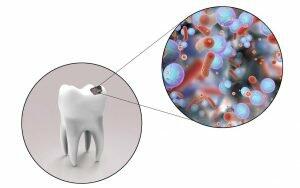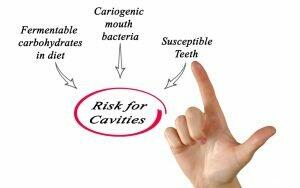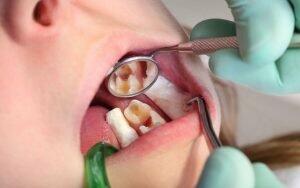Cavities, simply, are openings through the protective structure of teeth caused by infectious bacteria. The protective outer surface of the tooth is enamel. Other protective areas of tooth structure are called dentin and cementum. Enamel is the hardest/strongest structure in the human body, even stronger than bones. Cementum and dentin on the other hand are softer and, when exposed to the oral cavity, can form soft areas or cavities at a much faster rate. Enamel, cementum, and dentin all have a similar purpose: to protect the pulp of the tooth, which is the area where the nerves and the rich blood vessels that feed the tooth reside.
Cavity formation can take time. Initially, the rise in the acid level due to cavity-causing bacteria results in breakdown of the external portion of the tooth structure. This breakdown either continues with further degradation of the tooth structure or can be halted and reversed through application of fluoride and the buffering/re-mineralizing effect of saliva.
Increased acidity of the mouth occurs through consumption of carbohydrates which, when left on or around the teeth, is consumed by infectious bacteria which secrete their by-products (bacterial waste). The bacterial waste increases the chance of cavities forming on the teeth. Good home care is important to rid the teeth of food particles so this process cannot begin.
Cavity Prevention
Prevention of cavities starts with brushing with a fluoride toothpaste three times a day, for a minimum of two minutes each time, and flossing once a day. If a person is at high risk for cavities, a higher concentration of fluoride toothpaste or an added daily fluoride rinse is a good idea. As well, many medications have dry mouth as a side effect, which raises a person’s chance of developing cavities; thus home care is vital for prevention.
If you know that you have a cavity, it is important you attend to it. In the early stages, a cavity stays within the enamel; but if it travels to the underlying dentin, it can spread rapidly. Once a cavity goes through the dentin and into the pulp, it can cause infection, inflammation and discomfort. When the pulp becomes inflamed and infected, a root canal may be required (removal of the pulp and nerve of the tooth). Catching a cavity in its early stages is key.
Cavity Treatment
In order to treat a cavity, a dentist will remove the soft area (cavity) of the tooth and replace it with a filling. The filling will take the space where the cavity was and protect the inner portions of the tooth, just as the enamel once did. It is important to keep the area around the filling as clean as possible to prevent new cavities from forming.
In some areas water is not fluoridated so the use of fluoride toothpaste can be vital in the prevention of decay. Fluoride is a mineral that binds to tooth enamel, aiding in the prevention of cavity-causing bacteria. In fact, the CDC calls the addition of fluoride to community water systems one of the 10 greatest public health achievements of the 20th century.
According to the Ontario Dental Association (ODA), “Tooth decay is the most common chronic childhood disease, one of the leading causes of absences from school and only a small percentage know that it’s an infectious disease.” In order words, do not put anything in your child’s mouth that has been in your mouth — and vice versa. Do not share food, utensils, toothbrushes, etc. The good news is, tooth decay is entirely preventable in almost all cases! Prevention of oral disease goes a long way.
Brush, floss, and rinse for good oral health!
To find out how we can help with your personal dental care routine, call us at 905-775-5307, or click here to schedule an appointment.


